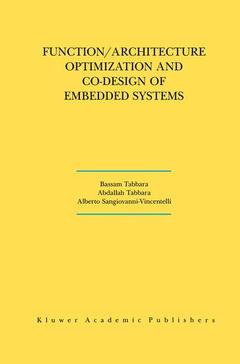Description
Function/Architecture Optimization and Co-Design of Embedded Systems, Softcover reprint of the original 1st ed. 2000
The Springer International Series in Engineering and Computer Science Series, Vol. 585
Authors: Tabbara Bassam, Tabbara Abdallah, Sangiovanni-Vincentelli Alberto L.
Language: English
Subject for Function/Architecture Optimization and Co-Design of...:
Keywords
Hardware; architecture; embedded systems; formal method; optimization; software; system; tables
105.49 €
In Print (Delivery period: 15 days).
Add to cart
Function/Architecture Optimization and Co-Design of Embedded Systems
Publication date: 10-2012
248 p. · 15.5x23.5 cm · Paperback
Publication date: 10-2012
248 p. · 15.5x23.5 cm · Paperback
Approximative price 105.49 €
Subject to availability at the publisher.
Add to cart
Function/architecture optimization and co-design of embedded systems (Springer Int. Ser. in engineering & computer science, vol.585) pod
Publication date: 10-2000
Support: Print on demand
Publication date: 10-2000
Support: Print on demand
Description
/li>Contents
/li>
Function Architecture Co-Design is a new paradigm for the design and implementation of embedded systems. Function/Architecture Optimizationand Co-Design of Embedded Systems presents the authors' work in developing a function/architecture optimization and co-design formal methodology and framework for control-dominated embedded systems. The approach incorporates both data flow and control optimizations performed on a suitable novel intermediate design task representation. The aim is not only to enhance productivity of the designer and system developer, but also to improve quality of the final synthesis outcome.
Function/Architecture Optimization and Co-Design of Embedded Systems discusses the proposed function/architecture co-design methodology, focusing on design representation, optimization, validation, and synthesis. Throughout the text, the difference between behavior specification and implementation is emphasized. The current need in co-design to move from synthesis-based technology to compiler-based technology is pointed out. The authors describe and show how performing data flow and control optimizations at the high abstraction level can lead to significant size and performance improvements in both the synthesized hardware and software. The work builds on bodies of research in the silicon and software compilation domains. The aforementioned techniques are specialized to the embedded systems domain. It is recognized that guided optimization can be applied on the internal design representation, no matter what the abstraction level, and need not be restricted to the final stages of software assembly code generation, or hardware synthesis.
Function/Architecture Optimization and Co-Design of Embedded Systems will be of primary interest to researchers, developers, and professionals in the field of embedded systems design.
Function/Architecture Optimization and Co-Design of Embedded Systems discusses the proposed function/architecture co-design methodology, focusing on design representation, optimization, validation, and synthesis. Throughout the text, the difference between behavior specification and implementation is emphasized. The current need in co-design to move from synthesis-based technology to compiler-based technology is pointed out. The authors describe and show how performing data flow and control optimizations at the high abstraction level can lead to significant size and performance improvements in both the synthesized hardware and software. The work builds on bodies of research in the silicon and software compilation domains. The aforementioned techniques are specialized to the embedded systems domain. It is recognized that guided optimization can be applied on the internal design representation, no matter what the abstraction level, and need not be restricted to the final stages of software assembly code generation, or hardware synthesis.
Function/Architecture Optimization and Co-Design of Embedded Systems will be of primary interest to researchers, developers, and professionals in the field of embedded systems design.
1 Introduction and Background.- 1 Introduction.- 2 System Level Design of Embedded Systems.- 2 Function/Architecture Optimization and Co-design.- 3 Design Representation.- 4 Function Optimizations.- 5 Function/Architecture Optimizations.- 6 Architectural Optimizations.- 7 Hardware/Software Co-Synthesis and Estimation.- 3 Overall Co-design Flow, Results, Conclusions, and the Future.- 8 Function/Architecture Optimization and Co-Design Flow.- 9 Synthesis Results.- 10 Conclusions and Future Research Opportunities.- References.- A C-Like Intermediate Format (Clif) for Design Representation.
© 2024 LAVOISIER S.A.S.




